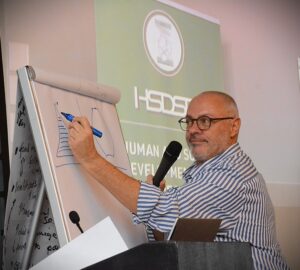By Sally Ncube, Regional Representative for Southern Africa, Equality Now
Harare, Zimbabwe, June 26, 2025: Across Southern and Eastern Africa, child marriage continues to rob millions of girls of their childhoods and future opportunities. While countries have introduced key reforms to address child marriage, implementation remains inconsistent, and survivors are often left without protection and support. To close these gaps, governments must domesticate and fully implement the SADC Model Law on Eradicating Child Marriage and Protecting Children Already in Marriage – a comprehensive legal and policy framework that criminalises child marriage and enforces a minimum age of marriage at 18 with no exceptions. Crucially, it ensures robust protection and multi-sectoral support for those at risk or already married.
Stakeholders across the continent commemorated the Day of the African Child on June 16th, and this continues to be an opportunity for countries to reflect, accelerate action, and strengthen their legal and protection mechanisms to protect children’s rights.
The theme for 2025, Planning and Budgeting for Children’s Rights: Progress Since 2010, reflects on advances made by African Union Member States in mainstreaming children’s issues into their national planning and budgeting processes, and encourages reform of budgeting and planning mechanisms to adopt a child rights-based approach. This includes integrating the SADC Model Law on child marriage into national legislation and committing adequate resources to enforce it.
African states need to make girls’ rights a priority by enacting and adequately resourcing laws and national plans of action to end child marriage and provide real protection, not just on paper, but in practice. Without bold legislative action backed by comprehensive investment, millions of girls will remain at risk.
Child marriage makes girls vulnerable to human rights violations
In 2022, UNICEF reported that 130 million women and girls in Africa were married during childhood. Nearly half the continent is currently under age 18, and the child population is projected to hit 1 billion by 2055, with UNICEF estimating that by the end of the century, nearly half of the world’s children will live in Africa.
Child marriage is both a cause and a consequence of the cycles of poverty, gender inequality, and marginalisation that hold women and girls back. Girls are far more likely than boys to be married off at younger ages and are more vulnerable to sexual, physical, and emotional abuse in relationships with unequal power balances.
Child brides are frequently forced to drop out of school, curtailing their education and reducing their long-term ability to gain independence, earn income, and provide for themselves and their families. Child marriage puts them at greater risk of early pregnancy and complications during pregnancy and childbirth, including obstetric fistula and maternal and infant mortality. Child marriage is also closely associated with female genital mutilation, as girls are often cut in preparation for marriage.
Strong commitments, weak implementation of child marriage protections
African countries have signed and ratified a range of regional and international human rights instruments that outline states’ obligation to protect the rights and welfare of women and girls. However, gaps between commitment and implementation remain wide. Governments need to examine domestic laws and align legislation, policies, and practices with regional and international standards.
Weak enforcement of progressive laws against child marriage is a widespread problem. This is illustrated in a recent study by Women in Law Southern Africa and Equality Now – An Analysis of the Laws and Policies in Place for the Protection and Support of Victims/Survivors of Child Marriages in Zimbabwe: A case Study for Epworth – which identifies numerous shortfalls in support for child marriage survivors. Poverty and challenges accessing information, public services and legal assistance contribute to persistently high child marriage rates.
The African Charter on the Rights and Welfare of the Child (ACRWC) contains explicit provisions against child marriage. Article 21(2) is the most direct and significant clause to address harmful social and cultural practices and leaves no ambiguity about the Charter’s opposition to child marriage and betrothal. It obliges State Parties to enact legislation that sets the minimum age of marriage at 18 years for both girls and boys. It also requires compulsory registration of all marriages in official registries, a critical measure for monitoring and enforcing legal compliance.
The Protocol to the African Charter on Human and Peoples’ Rights on the Rights of Women in Africa, known as the Maputo Protocol, contains explicit provisions addressing child marriage. The preamble clearly specifies that any practice that hinders or endangers normal growth and affects the physical and psychological development of women and girls should be condemned and eliminated.
Article 1 commits State Parties to combat all forms of discrimination against women through appropriate legislative, institutional, and other measures, while Article 5 obliges countries to prohibit and condemn all harmful practices that negatively affect the human rights of women, and which are contrary to international standards.
Article 6(a) stipulates that no marriage shall take place without the free and full consent of both parties, while Article 6(b) establishes that 18 is the minimum age of marriage for women, setting a clear legal standard for outlawing marriage below this age.
SADC Model Law helps countries tackle child marriage
The SADC Model Law on child marriage is a roadmap for government action, and underscores the need for national legislation to set the minimum age of marriage at 18 without exception, and for child marriages to be considered null and void.
In some countries, there are conflicting or contradictory laws. Constitutions or civil laws set the minimum age of marriage at 18, while permitting exceptions with parental or judicial consent, or exempting customary or religious laws from the scope. All legal frameworks must be harmonised to clearly and consistently prohibit child marriage under all circumstances.
Related News
Sentencing guidelines should be provided to ensure sentencing reflects the gravity of offences and is uniform across all legislation. In addition, termination of pregnancy should be allowed in any circumstance involving sexual exploitation of girls, including child marriage.
A holistic approach to ending child marriage
Adopting a holistic approach in tandem with criminalisation is critical and should be mainstreamed into national policies, strategies, and action plans. The Model Law requires countries to address underlying socio-economic factors that contribute to child marriage, such as poverty and a lack of access to education, and it mandates the provision of comprehensive support services through a multi-sectoral approach tailored for the needs of children currently married, survivors, and those at risk.
States are called upon to provide access to health services, birth registration, psychosocial support, legal aid and justice, shelter and safe spaces, protection against violence and exploitation, education, and economic empowerment and livelihood assistance. This should be coupled with increased investment in service providers and institutional and support systems.
African governments must also take urgent action to accelerate progress by resourcing comprehensive legal and policy reforms and investing in robust accountability mechanisms. The Model Law promotes accountability among Member States by stipulating the need for transparent monitoring and evaluation frameworks that track implementation and progress.
Ending child marriage is not only a legal and moral obligation – it is an imperative for achieving sustainable development. When girls are empowered, they are more likely to delay marriage and childbirth, complete their education, and have more successful careers. These outcomes have ripple effects, lifting girls and their families out of poverty, boosting national productivity, and strengthening communities.












